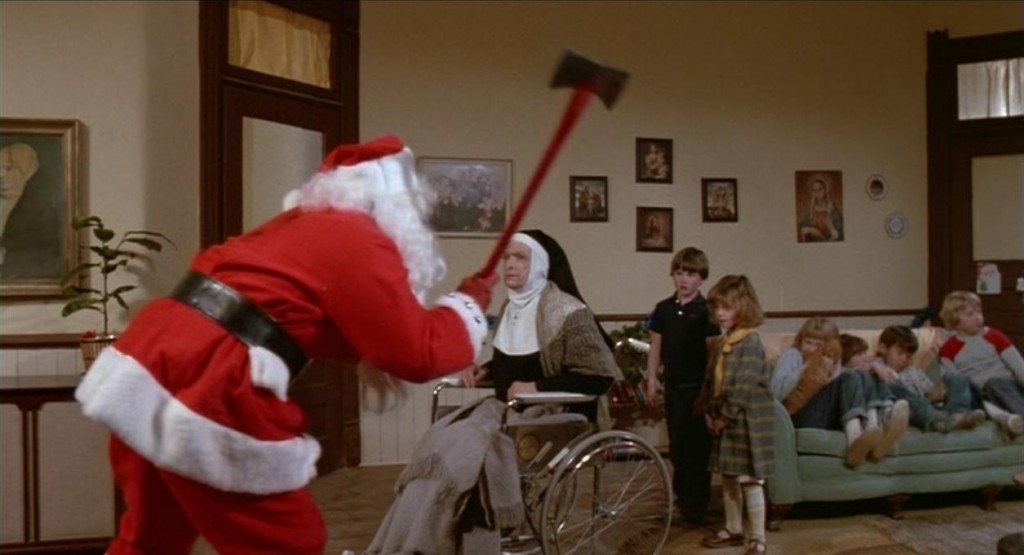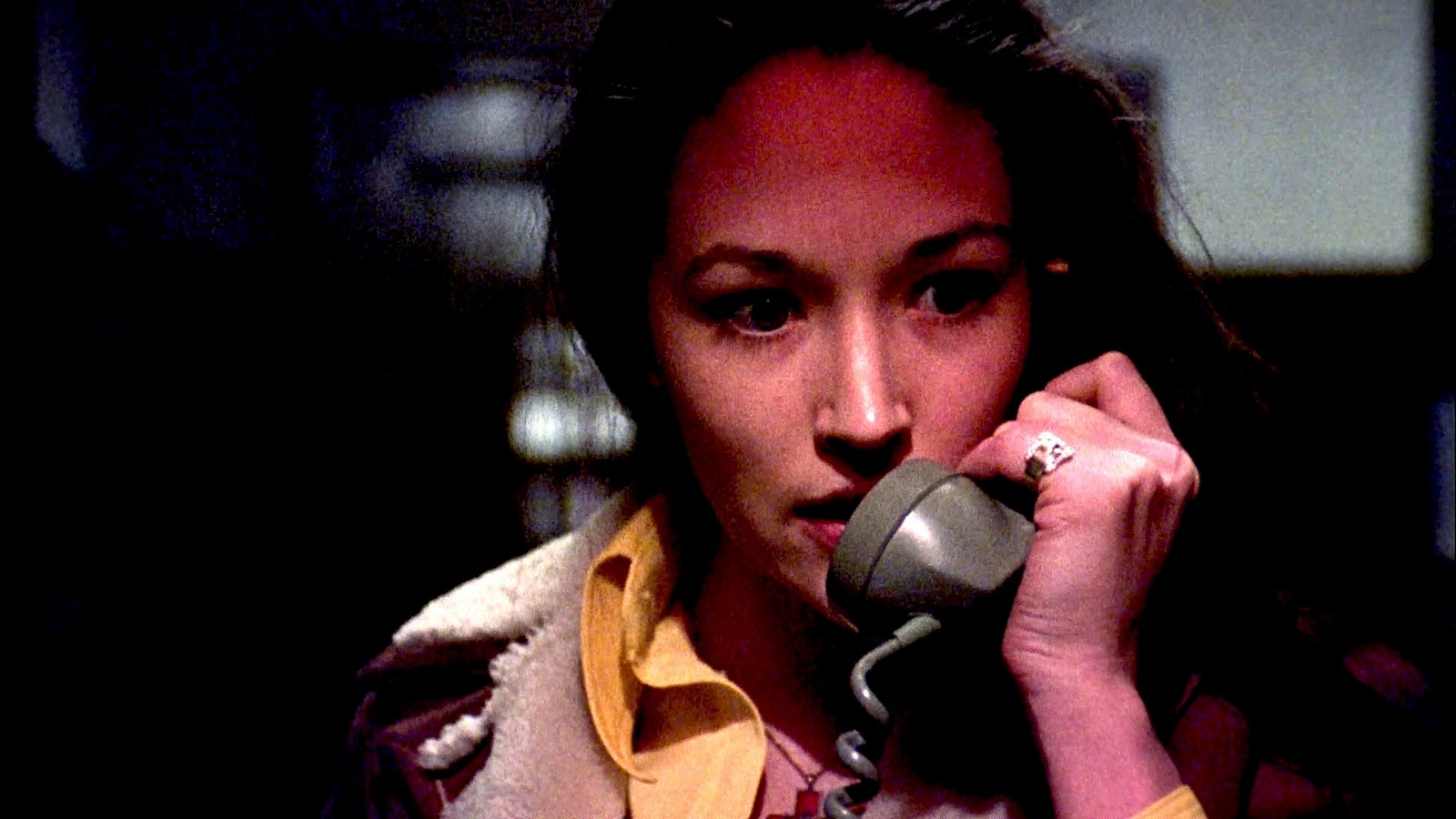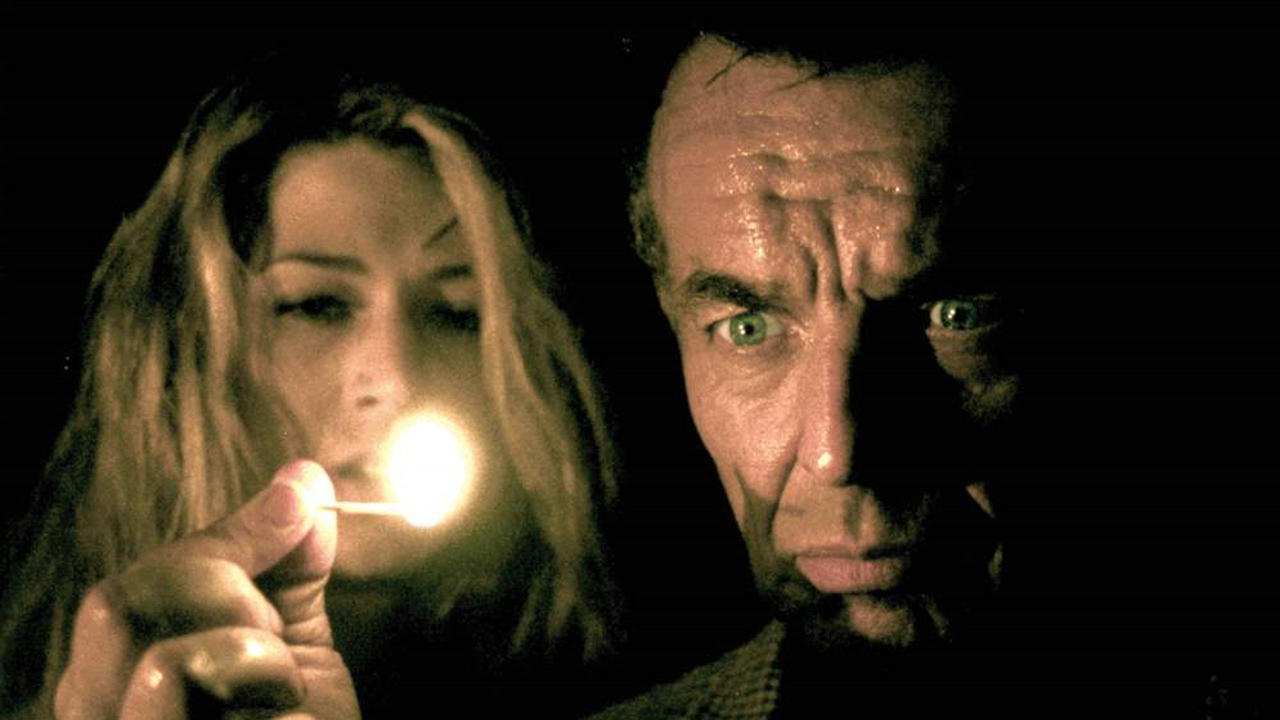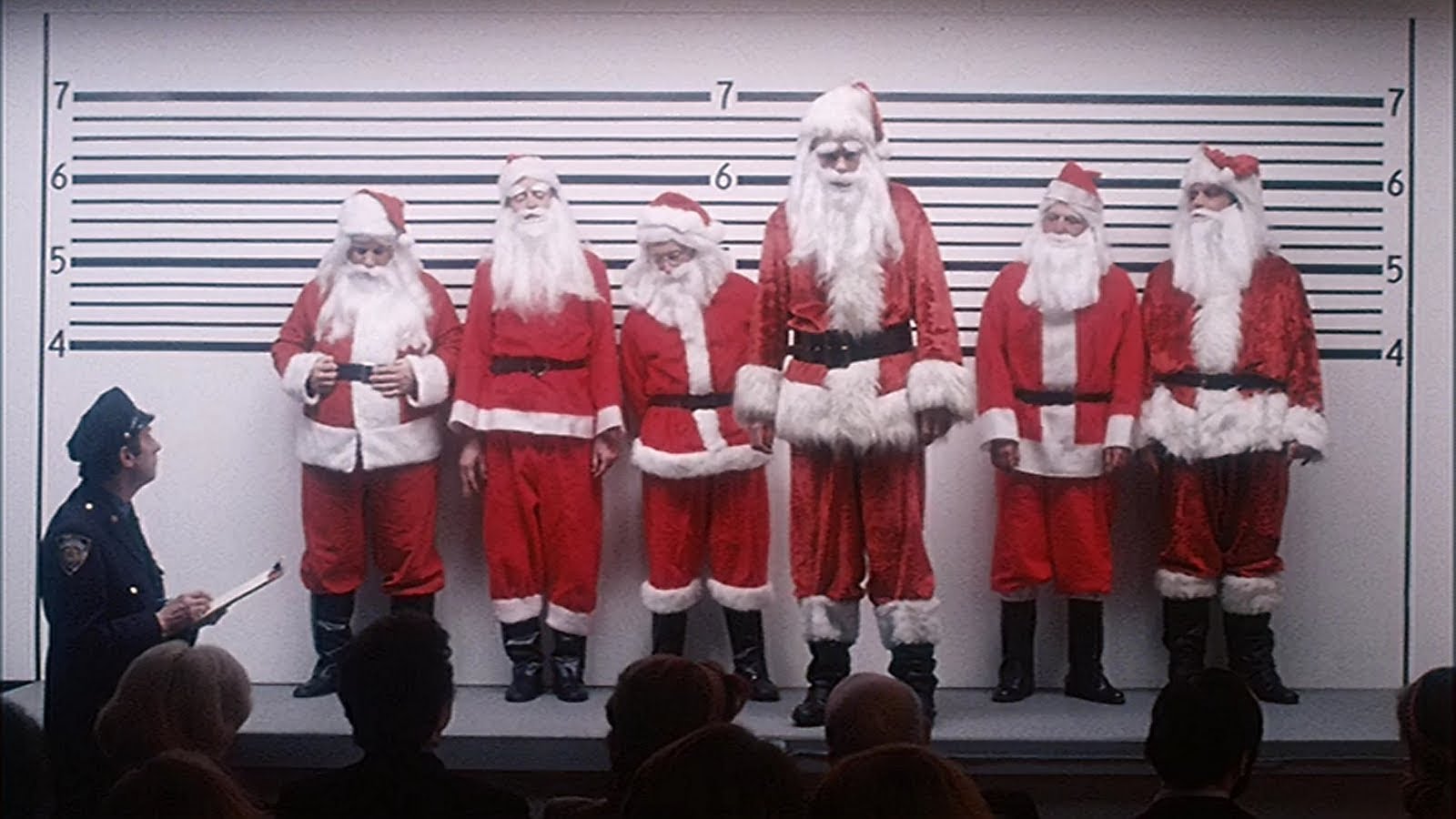6. Silent Night, Deadly Night (Charles E. Sellier, 1984)

Driving back home from a visit to Billy and his brother’s grandfather (who previously and briefly regained clarity from his semi-vegetative state to tell his grandchild that Santa Claus punished bad people) their parents are brutally murdered by a Santa Claus-dressed hitchhiker before their eyes. After this traumatic episode, Billy is forced to believe in Christmas and Santa Claus by the Mother Superior of the orphanage he now lives in with his brother.
Every time the season is near, Christmas iconography induces him to recall past experiences, even when he is supposedly a recovered young adult working in a toy store; a sexual offence he witnesses between the girl he has interest in and a work colleague send him back to his mother’s violation before death and drives Billy into a succession of killings dressed as Santa. Seeking revenge he sets out on a deadly trip towards the orphanage.
Together the big success that slashers were having during the eighties decade and the outcome the advertising campaign obtained helped “Silent Night, Deadly Night” in its popularity rise, even collecting twice as the amount of money it cost. Not only the trauma a character as Santa Claus can cause in a child is core to the film but also extreme religiousness is added to the mix along the disjunctive categorization between good and evil.
The taboo status that religion has turned sex or sexual violence into is a regular resource in horror films, they appeal to instincts and emotional impulse as violence promoters. If the Mother Superior has created in Billy the idea that sexual temptations are sinful and he also witnessed how his mother suffered this kind of aggression before being murdered, Billy’s killing code seems clear. “Silent Night, Deadly Night” embraces the most common fears kids experience through childhood and blends them in a forceful way: parent loss, severe education, attitude changes in loved ones and transformation of harmless icons into dreadful ones. There is no better period to do it than Christmas, when kids long for a stranger to come home and leave them presents under the tree.
7. Black Christmas (Bob Clark, 1974)

Inside a sorority house, during Christmas break, some girls are celebrating when they start receiving strange anonymous calls and start appearing dead as well. Inspired by murders occurred during Christmas in Québec and in an urban myth of the sixties, the script treatment is, without a doubt, the most remarkable issue of this film.
A unique and incomparable atmosphere is created, not only because of its Christmas surrounded plot but also for being responsible of coming up with an impressive inventiveness with no need of flashbacks, explanations or delivering the narrative weight exclusively onto the most prevailing figure of this kind of tales, no other than the murderer.
The central piece of the story is based upon a series of disjointed and eerie telephone calls together with brutal murder scenes self-indulgence free that grants a ridiculous and unreal excess of violence.
Four years before John Carpenter shot his slasher “Halloween”, Bob Clark crafted what is believed to be the first official film of this subgenre but not so perfectly fit as Carpenter’s masterpiece; even though the aspects that shape the genre are clearly there: teenager victim typology, parent-child traumas retrieved and used to explain the murderer’s psyche and a typical significant celebration setting.
Clark always stated that Carpenter stole his idea of a sequel; when they discussed a feasible “Black Christmas 2” before “Halloween” was made where Billy would have been recently released from the psychiatric hospital.
Nevertheless, some narrative resources can be surprisingly foreseen, the abundant subjective shots, distorted parallel actions and its determination to step into the criminal’s shoes is shortly associated with the famous shot that opens “Halloween”, but it is also inevitable to recall the Italian masters and their obsession relating the killers crooked psyches immersion.
8. Dead End (Jean-Baptiste Andrea and Fabrice Canepa, 2003)

“Dead End” is a road movie with a sinister touch that leads us to a surreal descent to hell seen through the Harrington’s obscure experiences. The Harringtons are a clearly dysfunctional family travelling during Christmas Eve through a dark desolated road. After driving through this road every Christmas for 20 years, Frank, the father, risks himself and his family taking a shortcut.
Using five characters, a car and a road, “Dead End” transforms austerity into its greatest virtue making the most out of lack of presumptuousness creating an overwhelming and evil environment. A sour family relation-related review can also be seen; certain dramatic stress moments are used to release shocking burdens, where characters, overwhelmed by panic and despair, let go of their sincere thoughts or reveal their shameful secrets.
A situation many times seen to describe limiting situations, seeing death or doom closely, sincerity arises and so do those disgraceful secrets and the inevitable sense of guilt. A worn out resource in genre films that orbit around a multiple family relationship; while in most cases, these bonds turn out reinforced and family unit wins over the menace, the result here is a bit less encouraging.
9. 3615 code Père Noël aka Game Over (René Manzor, 1990)

On Christmas Eve, a psychopath dressed as Santa breaks into the house of his former boss, where a boy and his grandfather will try to survive as they can. A strangely undefined movie with science fiction hints that showed the same year as “Home Alone” (Chris Columbus, 1990) but has little approach similarities. “Game Over” is in contraposition with to the rest of film productions of the year; a film that displays innocence of childhood, mind-generated fantasies and how reality twists dreams.
On the other hand, this starting point works as an excuse to develop a whole intrigue storyline around an apparently harmless character like a child who, in a matter of minutes, sees himself forced to get rid of all his innocence to protect his life and his grandfather’s.
Thus, Manzor’s film turns out to be a big hunting game where, the one that seemed to be the hunter (reinforced thanks to a great production design task and cinematography) is no more that the hunted, even though the odyssey the leading role has to go through is tremendous.
10. Christmas Evil (Lewis Jackson, 1980)

Harry is a weird man that works in a toy factory; he loves kids and wishes he were Santa. He keeps a record of kids who deserve presents for Christmas and those who don’t on a notebook. So the Christmas time of 1980, he will dress as him and start deciding who’s been good and who’s been bad and the latter will receive a very special gift this year.
Disrupted childhood again, being told Santa doesn’t exist and seeing his father disguised as him having sexual intercourse with his mother, Harry grows truly obsessed with this winter holiday icon. “Christmas Evil” opts for a psychological side and has a low corpse and gore content, not a slasher, but instead a melancholic and psychological thriller that creates a huge empathy towards its main character.
The progressive decay of human mind, symbol of the utopic pureness trampled by cynical pragmatism and daily vulgarity, Santa’s figure is almost portrayed as the tool for humans to give vent to their frustrations. An alienated and confused being in a mean world of ridicule puppets in which children believe and parents see only as entertainment buffoons.
BONUS: Treevenge (Jason Eisener, 2008)

“Treevenge” is a wild and tremendously gore short film that tells the consequences of continued abuse Christmas trees are subdued to. Sick of the unfortunate treatment they receive, they decide to claim revenge over humans.
A short film that casts aside complexity for presentation using rich visual aesthetic aspects, setting off an innovative but simple idea where its background holds no philosophic interpretations but mere entertainment.
Author Bio: Marina Berlanga is a freelance artist from Barcelona, she loves films and manages to cancel all her plans to go to the cinema. Friends and family request bringing her back home if you see her in a movie theater.